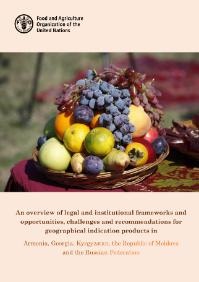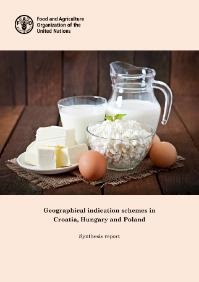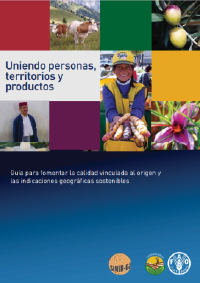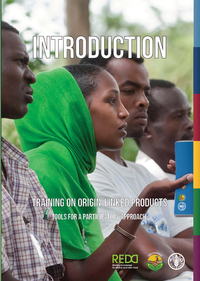VIDEOS
INDICACIONES GEOGRÁFICAS -
AN OPPORTUNITY FOR BIODIVERSITY
INDICACIONES GEOGRÁFICAS -
CONNECTING PEOPLE, PLACES AND PRODUCTS
PUBLICACIONES

Evaluating geographical indications
Guide to tailor evaluations for the development and improvement of geographical indications
Geographical indications represent a powerful way to foster sustainable food systems through territorial approaches and market linkages, especially for small-scale actors. In this perspective, and following the FAO publication methodologies of the origin-linked virtuous circle, local actors need to well define their geographical indication (GI) system and, more specifically, the product specifications as well as monitor and evaluate the impacts and readjust the system as necessary for the reproduction of local resources. These guidelines aim at providing a detailed and stepwise approach with specific tools to help practitioners in establishing their framework in relation with their objectives and local conditions, to help both the qualification though a prospective evaluation, and the reproduction of local resources though retrospective evaluation.

An overview of legal and institutional frameworks and opportunities, challenges and recommendations for geographical indication products in Armenia, Georgia, Kyrgyzstan, the Republic of Moldova and the Russian Federation
Geographical indication (GI) schemes can play a special role in promoting sustainable rural development, improving farm income and opening new export potential. Natural factors such as soil, climate and plant varieties play a major role in producing a unique product. Usually, GIs comprise knowledge and skills passed on from generation to generation, helping to protect local heritage. This report is a synthesis of the five national reviews of the legal and institutional frameworks in Armenia, Georgia, Kyrgyzstan, the Republic of Moldova, and the Russian Federation. It has been developed on the expert level to raise awareness and to serve as guidance for further activities to be considered and developed at a technical level.

Geographical indication schemes in Croatia, Hungary and Poland
Geographical indication (GI) schemes can play a special role in promoting sustainable rural development, improving farm income and opening new export potential. Natural factors such as soil, climate and plant varieties play a major role in producing a unique product. Usually, GIs comprise knowledge and skills passed on from generation to generation, helping to protect local heritage.General rules concerning geographical indications (for food products) are the same in all European Union countries. In light of this, the aim of the report is not to focus on the solutions of the community; rather, the report attempts to answer the question of how and for what purpose European quality policy tools are used in these countries. The report covers lessons learned from GI-system implementation and from the perspective for this sector, including the role of GIs in agriculture and rural development policy. The report also contains recommendations for the future. same in all European Union countries. In light of this, the aim of the report is not to focus on the solutions of the community; rather, the report attempts to answer the question of how and for what purpose European quality policy tools are used in these countries. The report covers lessons learned from GI-system implementation and from the perspective for this sector, including the role of GIs in agriculture and rural development policy. The report also contains recommendations for the future.

Indicaciones geográficas para sistemas alimentarios sostenibles
Conservar y promover el patrimonio agrícola y alimentario
Una Indicación Geográfica (IG) eficaz puede prevenir la deslocalización de la producción, crear empleo, impulsar el desarrollo local y contribuir a una alimentación segura, variada y saludable gracias a la conservación de productos alimenticios tradicionales, del medio ambiente y de la biodiversidad.Available also in Arabic, Russian, French, Chinese, English.

The nutrition and health potential of geographical indication foods
Traditional foods, diets and food systems play an important role in people’s nutritional status. As products of traditional food systems, geographical indication (GI) foods have a great potential to contribute to healthy diets and curb
non-communicable diseases. This paper presents five case studies around the world on the nutritional potential of registered GI foods and explores the link between the production processes and the nutritional composition of the final products.
The paper also discusses the development of GI specifications to maintain
and improve nutritional values, the role of GI foods in healthy diets, and the determination of food composition. Finally, suggestions on how to leverage GI foods for healthy diets are provided.

Uniendo personas, territorios y productos
Promover los vínculos entre las personas, los lugares y los productos agrícolas y alimenticios puede ser un instrumento que favorece el desarrollo rural sostenible en muchas comunidades rurales del mundo. De hecho, los productos vinculados al origen muestran unos atributos de calidad unidos a unos lugares geográficos y a unas personas que son el resultado de un saber hacer y unos recursos naturales locales específicos y que, con el tiempo, construyen una reputación colectiva, que se identifica por una indicación geográfica (IG).La definición de dicha calidad específica gracias a un pliego de condiciones y a la gestión colectiva del sistema IG son instrumentos fundamentales para determinar y conservar los recursos humanos y naturales, potenciando así los efectos económicos, sociales y ambientales. El objetivo de la presente guía, fruto de experiencias de campo de la FAO y de la red de investigación SINERGI en todo el mundo, es ofrecer a los actores locales un marco conceptual, ejemplos y metodologías concretas para la promoción y la preservación de productos de calidad vinculada al origen y la implementación de IG.
En la guía se propone un proceso que consta de cuatro fases a fin de fortalecer el círculo virtuoso de la calidad vinculada al origen. La identificación de los vínculos entre el producto de calidad específica y los recursos locales, la calificación con el pliego de condiciones y el reconocimiento de la IG como un activo colectivo de base territorial, la remuneración gracias a los enfoques de comercialización y la reproducción de los recursos locales en un enfoque a largo plazo, son las fases principales que permiten una sostenibilidad económica, sociocultural y ambiental del sistema de producción vinculado al origen.
Also available in Chinese, French, English, Russian, Croatian and Polish.

Linking people for quality products: Sustainable interprofessional bodies for geographical indications
FAO and REDD have worked together to provide a complete training tool supporting a bottom-up approach, for the promotion of origin-linked quality and sustainable geographical indications. In addition to the first training material for the development of participatory procedures to preserve and promote quality products, centred on the virtuous circle of origin-linked quality, this present volume, Linking people for quality products: sustainable interprofessional bodies for geographical indications and origin-linked products, focuses on the “remuneration” phase and specifically the producers organization. Management and promotion of the specific qualities of geographical indications (GIs) by local stakeholders gathered together in a collective management organization – the interprofession, or joint body is central to the commercial success, and ultimately to the sustainable impact, of any initiative to promote the link between a product and its origin.
The content and theory pages of this training manual set out the basic concepts, while the exercise sheets provide for participative activities. The trainer notes, together with the introduction, guide trainers in the preparation of tailored training in relation to the five steps of the virtuous circle.
Book 1: Introduction
Book 2: Content and theory
Book 3: Trainers notes
Book 4: Exercise sheets
Book 5: Case studies

Training on origin-linked products - Tools for a participatory approach
The Quality & Origin Programme of FAO and REDD have jointly developed this training material for the promotion of origin-linked quality and sustainable geographical indications in a participatory process. Based on the guide “Linking People, Places and Products”, the “Content” sheets provide with the concepts, while the “Exercise” sheets provide with participative activities. The “Trainer” sheets together with the “introduction” will guide the trainer in the preparation of a tailored training in relation with the 5 steps of the virtuous circle.
Volume 1: IntroductionVolume 2: Sheets Trainer
Volume 3: Sheets Contents
Volume 4: Sheets Exercise

Globally Important Agricultural Heritage Systems, Geographical Indications and Slow Food Presidia
This technical note highlights the specificities of each of these three approaches, as well as the potential linkages and synergies that could be leveraged for the common goal of preserving local food systems while achieving the Sustainable Development Goals.
Also available in French.

Identificar los productos de calidad vinculada al origen y sus posibilidades de favorecer el desarrollo sostenible
Una metodología para realizar inventarios participativos
En el presente documento, que se enmarca en el programa sobre la calidad específica vinculada al origen de la FAO, se propone un enfoque metodológico participativo para la identificación de productos de calidad vinculada al origen que pueda potenciar el desarrollo rural y sostenible a través de un círculo virtuoso basado en ellos.
Also Available
in English and
French.

Strengthening sustainable food systems through geographical indications
An analysis of economic impacts
This study seeks to provide empirical evidence on the economic impacts that are generated through the Geographical Indication (GI) process. It focuses on the food sector and reviews nine cases, offering a variety of national contexts and local value chains. The synthetic outcome of these nine cases show the positive effect of GIs on the economy and confirm the importance of specification that is well defined and implemented through producers’ coordinated action.
Publicaciones de los socios

Continental Strategy for GIs in Africa (2018 - 2023)
The African Union (AU) requested FAO’s support to establish a continental strategy for GIs with three main objectives: (1) enhancing GI stakeholders’ networking at national level; (2) preserving and promoting traditional products on local markets and (3) positioning them on international markets. This strategy was endorsed by the African Union in October 2017.

